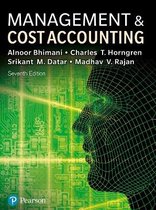Summary
Summary Management and Cost Accounting, ISBN: 9781292232669 Management Accounting 1 For Business
- Course
- Institution
- Book
Summary Management and Cost Accounting, ISBN: 2669 Management Accounting 1 For Business, Contains screenshots of the book with some examples.
[Show more]




